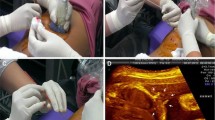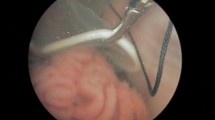Summary
In this review the indications, techniques, results and perspectives of operative fetoscopy are described and discussed. Prenatal invasive therapy is indicated if postnatal therapy comes too late and fetal disease may lead to irreversible damage or death if it is left untreated. Potential candidates for intrauterine surgery are pregnancies with the following problems: diaphragmatic hernia, infravesical obstruction, sacrococcygeal teratoma, chorioangioma, neural tube defects, twin-twin transfusion syndrome and acardiac twin. The aim is to improve the intrauterine situation by minimally invasive surgery and to prevent irreversible damage. After delivery permanent repair is possible in cases with fetal malformations. Diaphragmatic hernia is the best example for the development from maximally invasive open fetal surgery to minimally invasive endoscopic surgery. There is still a lot of experimental work to be done, for example for the correction of diaphragmatic hernia and neural tube defects. However, in other areas such as severe second trimester twin-twin transfusion syndrome, endoscopic surgery is a well established technique in certain centres for fetal medicine. Endoscopic laser coagulation of the vascular placental anastomoses is a causal therapy and shows better results than serial amniodrainages. After 160 laser coagulations performed in our institution, the survival rates are as follows: overall 68 % of fetuses, with two survivors in 54 % and at least one survivor in 83 % of pregnancies.
Zusammenfassung
Es werden in dieser Übersicht die wichtigsten Vorbedingungen, Indikationen und Techniken der operativen Fetoskopie beschrieben und deren Ergebnisse und Perspektiven diskutiert. Eine pränatale invasive Therapie hat immer nur dann einen Sinn, wenn die zur Verfügung stehende postnatale Therapie zu spät kommt und die Erkrankung des Feten bereits intrauterin zu irreversiblen Schäden oder zum Verlust des Kindes durch den intrauterinen Tod oder eine Fehlgeburt führt. Als Indikationen kommen in Betracht: Zwerchfellhernie, Obstruktionen der unteren Harnwege, sakrokokzygeales Teratom, Chorioangiome, Neuralrohrdefekte, Zwillingstransfusionssyndrom und Akardius. Das Ziel ist, auf minimal invasive Weise die intrauterine Situation so zu verbessern, daß ein irreversibler und meist letztendlich letaler Schaden vermieden wird und die postnatale chirurgische Therapie eine gute Prognose hat und eine endgültige Korrektur ermöglicht. Naturgemäß befinden sich viele Lösungsansätze noch im Experimentalstadium, wie z. B. die intrauterine Chirurgie bei Neuralrohrdefekten, in anderen Bereichen aber, wie dem Zwillingstransfusionssyndrom, haben sich endoskopische Operationstechniken bereits etabliert.
Similar content being viewed by others
Author information
Authors and Affiliations
Rights and permissions
About this article
Cite this article
Hecher, K., Zikulnig, L. & Hackelöer, BJ. Perspectives of operative endoscopy in fetal medicine. Gynäkologe 32, 855–865 (1999). https://doi.org/10.1007/PL00003192
Published:
Issue Date:
DOI: https://doi.org/10.1007/PL00003192




